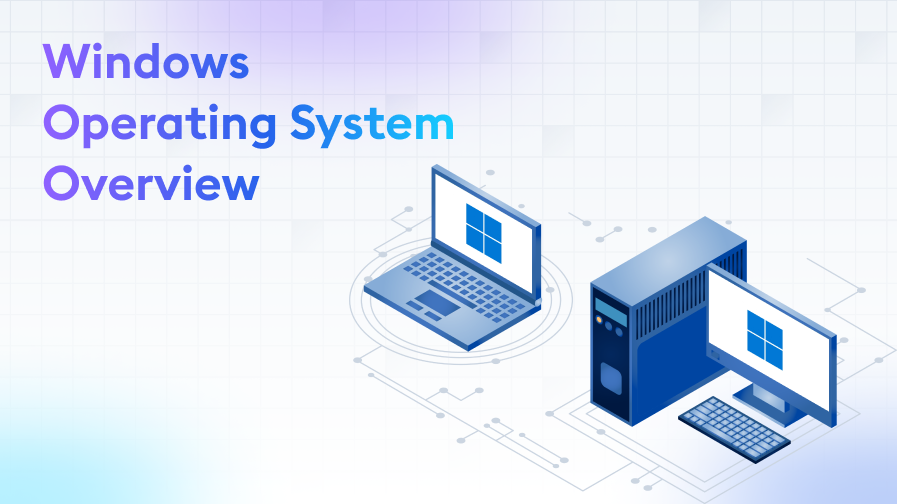Articles

Windows Operating System Overview
Windows Operating System
20/09/2023 13:09
Serhat P.
7 min. reading
Microsoft's Windows operating system stands as one of the stalwarts in the computer world. Since its initial release in 1985, Windows has solidified its place in the industry, continuing to impress with its innovative offerings. In this article, we will delve deeply into the evolution of the Windows operating system, exploring the pivotal innovations in its desktop and server versions.
1.The History of Windows Operating System
Introduced by Bill Gates in 1985, Windows 1.0 featured an interface that allowed users to easily switch between programs. This system, seen as a significant innovation at the time, made computers more user-friendly thanks to its graphical user interface (GUI).
Over the years, Microsoft continually updated and enhanced the Windows operating system. With Windows 95, it introduced the start menu and taskbar, elevating the user experience. Microsoft increased stability and security with Windows XP, offered a modern and stylish interface with Windows 7, and aimed to cater to mobile devices with Windows 8.
Most recently, Microsoft took significant steps toward the future of the operating system with Windows 10 and 11, enriching the user experience even further.
2.Windows Desktop Versions
The desktop versions of the Windows operating system have undergone substantial changes and developments over the years. Here are some pivotal innovations and features:
Windows XP
Launched in 2001, Windows XP is known as one of Microsoft's long-lasting and successful operating systems, drawing attention with increased stability and performance. It also managed to offer users a more modern experience with changes in the user interface.
Windows 7
Released to users in 2009, Windows 7 continued the success of XP, presenting a modern experience through transparent window borders and visual effects brought by the Aero interface. Moreover, innovations in the taskbar allowed users to switch between applications more easily.
Windows 8
Windows 8, launched in 2012, introduced the Metro interface targeting touchscreen devices primarily. However, the removal of the start menu met with backlash from users, with many finding it hard to adapt to this change.
Windows 10
In 2015, Windows 10 brought back the start menu based on user feedback, offering users flexibility and personalization. Additionally, incorporating the digital assistant Cortana facilitated a smarter experience for users.
Windows 11
Unveiled in 2021, Windows 11 boasts a modern and elegant design, providing a smoother experience through features such as a new start menu design, rounded corners, and improved snap functionalities. Furthermore, the restructuring of the Microsoft Store enables users to access many applications more easily.
3.Windows Server Versions
Windows server versions continually update and develop to cater to the needs of businesses. Here are some noticeable innovations and features:
Windows Server 2012
Released in 2012, this version placed a greater focus on cloud infrastructure, granting administrators more control through enhancements in the Server Manager interface.
Windows Server 2016
Unveiled in 2016, this version introduced container support, aiding modern application development processes. Moreover, enhanced security features allow businesses to protect critical systems more effectively.
Windows Server 2019
Launched in 2019, this edition focuses on hybrid cloud solutions. The introduction of the Admin Center permits IT experts to manage systems more straightforwardly through a centralized management panel.
4.Security in Windows Operating Systems
Microsoft constantly brings updates and innovations to ensure security in its operating systems, with security holding considerable importance, especially in server versions offering business solutions. The latest versions of the Windows operating system protect computer systems from malware and cyberattacks through advanced security features and tools.
At makdos.com, we facilitate Windows installations in virtualization platforms as per requests, providing necessary support to clients in case of issues. This allows customers to use the operating systems securely and access professional support during potential problems.
5.Performance Optimization in Windows Operating Systems
Windows operating systems offer users a faster and more stable experience through performance optimization tools. These tools enable users to remove unnecessary files from their systems, undertake disk consolidation operations, and increase system speed. Particularly, Windows 10 and 11 support new-generation hardware, promising users superior performance.
6.User-Friendly Features in Windows Operating Systems
Thanks to its user-friendly features, Microsoft stands as a highly preferred operating system for individual users. Specifically, features brought with Windows 11 like Snap Layouts and Snap Groups facilitate multitasking for users.
Moreover, features such as DirectStorage and Auto HDR have elevated the gaming experience. These critical features for gamers ensure quicker game loading and better graphic performance.
7.Windows Education Versions
Microsoft also offers Windows education versions specially designed for the education sector. These versions come with tools and security features customized for students and teachers, allowing users in the education sector to work securely and efficiently.
8.Windows Operating Systems of the Future
Guided by a strategy focused on sustainability and innovation, Microsoft aims to shape the operating systems of the future. Particularly, the integration of technologies such as artificial intelligence and machine learning into operating systems aims to offer users a smarter and more customizable experience.
Moreover, the company's ongoing work on developing a Windows operating system for Quantum computers showcases its vision for the future. Through this, Microsoft intends to push the boundaries of technology, targeting to provide more effective solutions to users.
Conclusion
Windows operating systems have exhibited a constantly evolving and renewing structure from the past to the present. Aiming to offer a better experience to users with every new version, Microsoft maintains its leadership in the operating system market.
With its innovations and user-friendly features, Windows operating systems offer users a safe, stable, and efficient working environment. Through strategies and innovations for the future, Windows aims to offer a better experience to its users.
